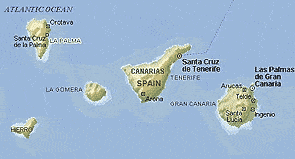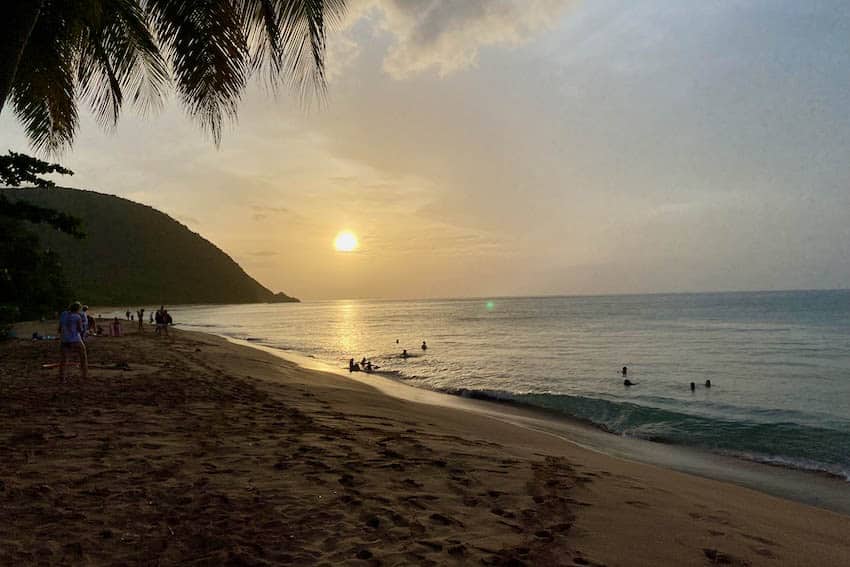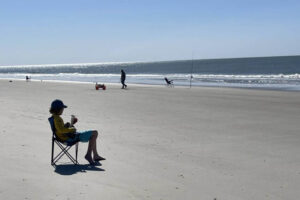The Canary Islands: Hiking, Wild Carnival, and Volcanic landscapes
By Joe Cawley and Lucy Corne

WHERE
The seven Canary Islands, although politically Spanish, are geographically African and are situated in the Atlantic Ocean, the closest island is just 60 miles from the coast of Morocco.
WHY GO
The Canaries’ tropical latitude ensures European culture bathed in year-round sunshine and the diversity of landscapes is unmatched anywhere in the world.
Barely known as a walking destination, the islands are a hiker’s paradise. You’ll barely see another hiker all day on many of the trails. The Canary Islanders are fiercely proud people, happy with their intrinsically simple way of life.
Unconcerned about the world’s modern riches, enjoying life is paramount and any excuse is welcome for a party, often involving the entire village or city population. These affairs are often long and noisy as each man vies for center stage, good-naturedly debating politics, sport, and the unwelcome influence of their mainland government.
WHEN
With an eternal Spring, anytime is a good time to go, but July through September are the busiest and the hottest months (average temperatures around the high 80’s), so are perhaps best avoided. and February is recommended to participate in the world’s third-biggest carnival, held over nine days in Santa Cruz, Tenerife. Most agree that the islands are at their best in January and February, after the rains.

GETTING THERE AND AROUND
Scheduled international flights come into the two major islands of Tenerife and Gran Canaria. Spain’s national airline, Iberia has regular services from most major European cities including London, Frankfurt, Rome, and Madrid (in the USA Tel; 1-800-772-4642).
All of the islands have airport and ferry (fredolsen.es, naviera-armas.com, trasmediterranea.es) links, and proficient bus and taxi services exist on Tenerife, Gran Canaria, and Lanzarote.
Cars and motorbikes can be rented at reasonable rates on all islands. There are also excellent if rather expensive flights connecting the islands (islasairways.com).
BEST MAJOR ATTRACTION
Mount Teide on Tenerife, is the world’s third-largest volcano and a cable car service will carry you up to its smoldering peak, the highest point in Spanish territory. Or you can hike, overnight at the AltaVista Lodge (Tel: +34-922-239811) to catch the dawn and watch Teide’s shadow reaching across the clouds below.
From here, the views are breathtaking and you can see all of the other islands if you’re lucky. But don’t be surprised or disappointed if clouds hinder this vista.

BEST UNUSUAL ATTRACTION
Las Cueva de Los Verdes (Green Caves)–named after the family that discovered them, not because of the color of the caves–of Lanzarote form an intricate underground network of lava tubes. Guides will take you through them narrating tales of pirates and hidden dangers.
BEST ACTIVITY AND TOUR
Many boats offer excursions to see the colony of pilot whales and dolphins that reside in Canarian waters. Try Must Cat Catamarans in Tenerife (Tel: +34 922 719603 or fax:+34 922 716339). Nashira, based in Ios Gigantes, is generally considered to be the most environmentally friendly outfit. See Trip Advisor reviews
BEST ALTERNATIVE
Try paragliding off some of Tenerife’s southern mountains. Tuition and tandem flights are available from Club Parapente Norte, If you fancy learning Spanish, the Don Quijote School in Puerto de la Cruz, Tenerife, offers residential classes for all levels.
BEST LOCAL HAUNT
Although isolated pockets of coastal towns have become quite commercial, inland you will find the real Canaries. Hidden villages of whitewashed charm built into mountainside caves such as in the Anaga Mountain region in the north-west of Tenerife. Make sure to get away from the water for a real taste of local culture.
El Hierro is virtually untouched by tourism and La Gomera unchanged by progress. There are jewels to be found everywhere but the most charming pueblos include San Andres (La Palma), Fataga, (Gran Canaria) Teguise (Lanzarote), La Olivia (Fuerteventura) and Masca (Tenerife).
BEST LODGINGS
All islands have paradors, state-controlled hotels that reflect the culture of the islanders (around $100 a room per night). Alternatively, casa rurals (country cottages) offer basic, but authentic self-catering accommodation for up to eight people. (ecoturismocanarias.com is a central reservation board for all the islands).
Don’t miss the opportunity to stay in a cave-dwelling in Artenara, Gran Canaria. Rural hotels vary in quality and price, but are usually very pretty and a great way to mix with different nationalities.
For a sample of Canarian architecture and furnishings try the beautiful 10-room Hotel El Refugio on Gran Canaria. website rooms are around $53 per night
BEST EATS
For a taste of tapas (local appetizers), La Pimientera in the hidden village of Masca, Tenerife is run by an English couple, Rob and Gina, and offers unparalleled views. (Tel: +34 922 863438). Rabbit is a specialty, as are papas arrugadas (potatoes boiled in their skin in salty water) served with a spicy mojo sauce. The locally produced goat cheese is outstanding, especially when taken with a glass of local wine.
The island of La Gomera is particularly famous for its fish restaurants and the tuna comes virtually straight from the sea to the plate.
El Pejin in San Sebastian is often recommended. Also don’t miss Casa Efigenia in the misty La Gomera mountain town, Las Hayas. The owner lovingly prepares a fully organic, vegetarian feast every day at lunchtime. The island’s best tapas joint is Tasca Pablos in the unlikely town of Granadilla, Tenerife. Los Llanos in La Palma has some excellent eateries and caters to vegetarians.
BEST ENTERTAINMENT
For lively nightlife, head for Playa de Las Américas in Tenerife (Tramps and Metropolis are recommended), or Puerto Rico in Gran Canaria. Some folks think these places are tacky and lack local character.
Try La Laguna’s laid-back student ambiance in Tenerife. Playa de Ingles in Gran Canaria is Europe’s largest gay resort. A spectacular flamenco show is performed at the Pirámide de Arona, Tenerife. (For reservations, Tel: +34 922 757549) For local music, visit any Spanish bar after 11 pm and the locals will undoubtedly burst into local folk songs and laments.
Music is often spontaneous, passionate and communal so be prepared to join in — even if that just means clapping out the rhythm.
BEST SHOPPING
A Sunday morning market near the old church in Santa Cruz, Tenerife, offers everything from local crafts to exotic fruits. The city of Las Palmas, Gran Canaria is the shopping center of the Canary Islands. Corte Ingles is a large department store popular with locals and visitors alike.
Don’t miss the superb farmer’s market in smaller towns across the islands. A great place to taste the local wine and foodstuffs and admire the local crafts.
VISAS AND DOCUMENTS
Since the Canary Islands are part of Spain, and Spain is part of the European Economic Community (EEC), visitors from other EEC countries and from Canada and the USA need only valid passports. Citizens of Australia, New Zealand, and South Africa must also have a visa.
HEALTH AND SAFETY
There is a relatively modern health service in place, but private insurance is recommended. Tap water should NOT be drunk. It is not dangerous but tastes vile. and those with respiratory problems ought to seek doctors’ advice as the islands are subject to hot sand storms blowing in from the Sahara Desert.
This mostly affects Lanzarote and Fuerteventura and is somewhat rare. Those with respiratory problems should also seek advice before attempting to conquer Mount Teide. Motion sickness can also be a problem, with the choppy boat crossings and winding mountain roads.
COMMUNICATIONS AND MONEY
The Euro is the accepted currency. Travelers’ checks and most major credit cards are widely accepted in the bigger towns. The telephone network, both terrestrial and mobile, has greatly improved over the past couple of years and international calls are now easily made. In larger towns and cities you’ll find Locutorios, the best place to make long-distance calls or buy a phone card. Fax and e-mail communication is also quite common in all but the smallest villages.
BEST BEACHES
Although the finest golden beaches are found in Fuerteventura, especially on the Jandia peninsula, there are some stunning places to sun yourself on the other islands. Las Canteras provides calm waters and is the perfect way to relax after a day of shopping in Las Palmas on Gran Canaria.
Further south, don’t miss the Maspalomos sand dunes. Other golden beaches worth a visit include the out-of-the-way Papagayo in the south of Lanzarote and the deserted playas on La Graciosa. There are some jewels in the western islands if you don’t mind black sand.
BEST WATERSPORTS
Scuba diving is popular across the islands, but the favorite spot is La Restinga in the south of El Hierro. Learn to windsurf with the professionals in the waters off Fuerteventura’s Sotavento Beach.
BEST HIKE
The 12.5 km hike from Alto de Garajonay to Hermigua in La Gomera offers spectacular views, verdant forest and even waterfalls, a rare Canary Islands site. The hike to the top of Mount Teide is demanding but worth it if you manage to visit on a clear day.
BEST RESOURCES
Island Connections is the largest English language newspaper in the Canaries and features a comprehensive visitors guide every two weeks
The award-winning Web site Canary-travel also has a wealth of information available in many languages.
Visitor information can also be obtained from the Canary Islands Tourist Freephone service at Tel: 902 371372
- These 9 U.S. National Parks Require Reservations in 2024 - April 17, 2024
- Take a Hike in Olympic National Park - April 17, 2024
- The Wild Mississippi: 2340 Miles Across Ten States - April 8, 2024






This guide is mostly a Tenerife advertisement.
Almost 80% is the suggestions lie there where that island is forever covered in clouds due to its mountain.
Almost no references to La Palma, Hierro or Fuerteventura.
Lanzarote has many more interesting places and by main Island you could tell it is only Gran Canaria the one considered metropolis by Spain gov standards. Obviously almost no mention to its amenities and resources.
Please take this advertisement with a grain of salt. This is far from being an accurate guide.